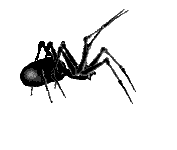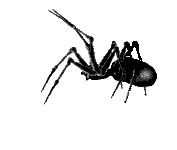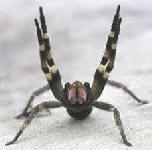 Brazilian
Wandering Spider
Brazilian
Wandering Spider
|
These large and dangerous true spiders are ranked among the most venomous spiders known to man. They are extremely fast, extremely venomous, and extremely aggressive. The venom from the Brazilian Wandering Spider is so toxic, that 0.006 mg. of its venom kills a mouse. These spiders are really creepy for several reasons. One, it’s fierce. This is not some wimpy spider that will run away at the first sign of a human, allowing careless hikers to escape a painful death without even knowing they’re in danger. No, these spiders will attack anyone and anything they see as threatening. They’re both deadly and aggressive. Second, they’re not incredibly easy to avoid. They get the “wandering” part of their name from the fact that they roam around, rather than live in a particular web or tree. In densely populated areas, you can imagine how many people get bitten by an aggressive spider that wanders all over the place. They’re responsible for more cases of venom intoxication in Brazil than any other animals. During the day they hide inside termite mounds, under fallen logs and rocks, and in banana plants. Their wandering nature is another reason it is considered so dangerous. In densely populated areas, they usually search for cover and dark places to hide during daytime, leading it to hide within houses, clothes, shoes, hats, cars, boots, boxes and log piles; thus generating accidents when people disturb it. It does not remain on a web, rather, it wanders the forest floor, hence the name. The Brazilian Wandering Spider has another distinguished common name - the Banana Spider. It was given the name "Banana Spider" because there have been cases where these spiders unintentionally appeared on banana boats heading for the United States. The Brazilian Wandering Spider should be held with the highest respect. For those who manage to obtain one of these deadly spiders, always remain vigilant and don't get bitten!
The Brazilian Wandering Spider can grow to have a leg span of up to 10-13 cm (4-5 inches). Their body length ranges from 17 to 48 mm
|


